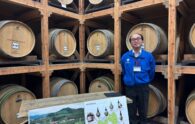We hear it over and over: This 2017-2018 period is seen as an important time for the ILC project, as we are fast approaching the Japanese government’s decision on whether or not to host the accelerator. We know many are curious as to the decision-making process, and we sat down with Prof. Atsuto Suzuki, president of Iwate Prefectural University and former head of Japan’s High Energy Accelerator Research Organization (KEK), to get some answers. He also let us know what his organization, the Tohoku ILC Preparation Office, is working on to get the Tohoku region ready to host the ILC.
First, can you let us know a little bit more about the staging of the ILC?* Have you gotten a consensus from the international community?
*Staging: Breaking the ILC’s construction into separate phases, starting off with a smaller accelerator and gradually adding length and power to it. The approach is now to start off with a smaller collider in the first stage.
Well, first of all, we’ve always had the concept of staging. When the Technical Design Report for the ILC was released in 2010, the research was divided into 3 stages over 30 years. The first stage is a Higgs boson factory at 250 GeV. The next step is a top quark factory at 300 GeV, and then finally the ILC’s power would be increased to 500 GeV.
All of these phases together would cost around 2 trillion yen over 30 years, including utilities (electricity, heat, water), labor, and maintenance and inspection costs. Japan would be responsible for 50% of that, or 1 trillion yen, which would equal to 35 billion yen per year (about the same yearly cost as KEK).
Here’s the reason we did it that way. The ILC community has seen what happened with the Superconducting Super Collider (a cancelled accelerator project) and also what’s currently happening with ITER (International Thermonuclear Experimental Reactor). If you start a project too early, before you have a chance to finish the R&D process, then costs could balloon past initial estimates. In the worst case scenario, this could lead to a project being cancelled. It is crucial to have a cost estimate we can trust, and to have an overall vision for the project. Furthermore, if we outline the possibilities of each stage of research within that vision, we can expect costs to further decrease thanks to future R&D after the project starts. That is a crucial step for starting the project sooner rather than later.
The international team has been deliberating what is necessary for the design of the 1st stage and a cost estimate as they keep in mind this overall view. The ICFA (International Committee for Future Accelerators, the group that ultimately oversees the ILC project) will hold a meeting in August, and at that meeting the staging plan will be brought up and released to everyone in order to gain consensus.
The first stage will also include the construction of the ILC, and will take 10 years. But as I said earlier, more R&D will have taken place by that time, and costs for the 2nd stage may go down. So in that sense, we’re glad that the staging process is taking place, and we think we’re headed down a good path.
Some in the community are worried that with staging, the ILC may stop at the first stage, and not reach its full potential. What do you say to that?
The first stage will be the ILC as a Higgs factory. We know for certain that the Higgs exists, and with the ILC, more precise experiments are possible. Once we see understand the Higgs, we will know what we will have to do next. I can understand the worry, but it’s very rare to be able to predict the outcomes of experiments. We must have foresight and conviction, remain patient, and go one step at a time with these experiments.
In another sense, the Large Hadron Collider at CERN is a discovery machine. It searches for new things that we haven’t discovered yet. However, many of the reactions that result during its experiments point to things we already know about. It’s not suited to in-depth research. With the linear collider at the ILC, we can perform highly precise experiments that elicit only the reactions we want. In my presentations, I often explain the LHC and ILC like this: The LHC searches for paths in a jungle with no paths. The ILC paves that path into a bigger path, and leads to the next generation of experiments.
We know the Higgs exists, and so with the ILC we know we will find our way to the next step. The ILC is not a gamble.

The author with Prof. Suzuki
What’s next for the project after the staging plan goes public?
At that point, we take the staging plan to MEXT (the Japanese Ministry of Education, Sports, Culture, Science, and Technology) and other related organizations. We will then petition them to further push along the deliberations between the US and Japan as quickly as possible, and to start deliberations between Japan and the EU, and Japan and other Asian countries. In particular, the scientists from around the world will begin planning their next 5-year strategy for high energy particle physics in 2018. In 2012, the Technical Design Report (TDR) for the ILC was released, and both the EU and the US strongly supported the ILC in Japan in their 5-year strategies at that point. In their statements, they placed strong hopes on a proposal from Japan. Almost five years have passed since that point. The time limit is fast approaching.
We will explain all of that to MEXT, and strongly urge them to just keep moving forward, one step at a time, and to show their intentions on the ILC. I always tell students this: “The old Japanese saying, ‘Speech is silver, silence is golden,’ doesn’t apply here. You can’t exist in today’s global society without speaking up for yourself.”
Does the budgetary process in Japan differ from the other member countries?
You could say that Japan is “digital” while the West is “analog.” In other words, until Japan’s Ministry of Finance authorizes a budget for the project, we cannot use official funds (for the ILC). Up until now, every time we’ve developed technology related to the ILC, it had to be called “development of advanced accelerator technology.” However, unlike the West, once the projected budget is authorized, the project would continue unless there was some sort of issue or accident. In the West, the ILC has been included in their budgets in stages corresponding to developments in the project. They’re called things like “the 2 year plan for technological development for the ILC.” Once the project starts, their budgets would be finalized as the “ILC Project Budget.” But if the project doesn’t show good results, then that budget could be taken away without warning.
With the ILC, every time there has been a new development, Western countries have included it in their budgets, and Western researchers are waiting on some sort of forward-looking sign from the Japanese government on the ILC as they continue their current research. But there has been no sign, making it hard for them to secure their research costs. When you push forward a global project like this, different cultures have different values, so we need policies that take into account how each country puts together its budget.

The ground is meant to represent a galaxy outside of Prof. Suzuki’s window. Mount Iwate in the background.
Can you tell us what the Tohoku ILC Preparation Office is working on this year?
There are so many things that the Tohoku region would have to work on once the government makes it decision. In order to work as one Tohoku towards these goals, we started the Tohoku ILC Preparation Office in the spring of 2016. Since then, the numerous working groups within have made the following advances:
・Selected a central interaction point taking into account the geography of the Kitakami mountains, ease of access, and cost. Started specific design of the underground facility
・Started working on establishing “zones” with different functions from Morioka to Sendai, in reference to the Grand Design(s) devised up to this point
・Created a campus design that will encourage exchange and more residents to the area, and a plan for building a diverse community
・Put together a list of the region’s leading challenges, which includes infrastructure like roads/getting permission to develop, and have started deliberating on their solutions
・Deliberated on creating national strategic special zones for the ILC research organization, the surrounding international city of science, and international science innovation.
・Suggested an overall design of the ILC international research facility that would use wood and other natural resources of the area
・Considered and made suggestions on how to build the accelerator: how to divvy up the creation of the various devices and parts among member states, scheduling, and how to accept/inspect/maintain/transport them in Japan
・Surveyed the geological state of the ILC candidate site through electromagnetic and elastic wave exploration, boring, and hydrological surveys (about half complete)
・Made suggestions about the international organization that would head the ILC
・Suggested a regional platform so that many companies can prepare for getting involved with the ILC
・Evaluated the economic effects of a Japan-hosted ILC
By the end of the 2017 fiscal year (March 2018), all of the working groups will wrap up their work and create a detailed report as well as a pamphlet (guideline series) that will introduce our overall strategy to the general public. Furthermore, after the staging plan is released, we would like to show MEXT that the Tohoku region is adequately prepared for the ILC.
Additionally, Iwate Prefectural University and Iwate Prefecture’s Office of Science and ILC Promotion are pushing forward initiatives that will foster a multicultural society. In particular, improving Japanese language education for non-native speakers. We’d like to develop the region as a place where you can learn Japanese no matter where you go. We are also working hard at introducing a one-stop total service that would support foreign residents from the moment they enter Japan until the moment they leave. As a part of that service, we hope to make use of an app about living in the area, designed by a professor at Iwate Prefectural University that was originally for senior citizens. He is now developing the app into something we can use.
A diverse society doesn’t just mean bringing in people from other cultures. We must evolve our society into one where everyone can live in harmony, at every age, without barriers. We hope to keep Iwate’s societal development in mind as we move forward.

The IPU Campus
What is being done to get an understanding of the ILC from the people of Japan?
First, we’re using a pamphlet from the ILC Preparation Office that explains in plain language the significance of the ILC, and how it will contribute to society, Tohoku, Japan, and the rest of the world.
Also, we have created opportunities for the people of Tohoku to get together to talk about what kind of region will be created with the ILC. Instead of concentrating existing resources and capital in one place, our goal is to develop the region so that all that functionality is spread over a wide area. We must share that goal with the general public. We’re not going to create a special place from scratch for foreign researchers and their families to live – We’re aiming to make every town a place where foreign researchers and their families will fit right in.
We’ll also be devising a “zone of international science”, “zone of international residence”, and a “zone of international industry innovation”, as well as a wide area zone stretching from Morioka to Sendai. Sharing this will be useful in encouraging people in the area to get excited about the ILC.
The ILC will open the doors to the future for Japan. It will create a Japan that challenges itself to become the next frontier of knowledge for humanity. It will create a Japan that will lead the world in the 21st century – the Asian Century – where people will gather and a new world culture will be born. It will revive Japan as a major manufacturing country through its effects on industry and technology. It will create innovation at a national level. And it will change Japan from a country that receives, to a country that gives.
We must work hard in spreading those ideas to the people of Japan, so that we can reach a common understanding.
Japanese
「ILCはギャンブルではない」岩手県立大学学長・元KEK機構長 鈴木厚人先生がILCを語る
和山アマンダ
2017~2018年はILCに関して日本政府が誘致判断をすると見込まれ、ILCの正念場であるとよく言われています。海外の研究者はその誘致判断に対する関心が高いため、誘致判断のプロセスや東北ILC準備室の活動について岩手県立大学学長・元高エネルギー加速器研究機構長である鈴木厚人先生にお話を伺いました。
Q)まず、ILCのステージングについて説明をいただけますか。海外のコミュニティーからコンセンサスをとっていますか。
*ステージングとは、加速器を段階ごとに建設することです。最初に短い加速器を建設して研究を開始し、その後、加速器を継ぎ足しエネルギーを増強して、新たな研究を行うことです。
A)まず、ステージングは最初から考えていたものです。 2012年にまとめたTDR(ILC技術設計報告書)には、第1期としてヒッグスファクトリー(エネルギー:250GeV)、次にトップ(クォーク)ファクトリー(300GeV)、そして最後に500GeVエネルギーと、30年間3段階研究で提案しています。
総経費は光熱水量費、労務費、保守点検費等をすべて含み30年間で約2兆円。日本の負担を50%とすると1兆円となり、約350億円/年で高エネルギー加速器研究機構の年間経費とほぼ同額です。
なぜステージングを最初から考えていたかというと、我々はSSC(超伝導超大型加速器、アメリカで中止になった加速器)、そして今のITER(熱核融合実験炉)の課題を見ているからです。
すなわちR&D(技術開発)を徹底的に行ってからプロジェクトを立ち上げないと、当初の見積り経費よりもどんどん膨らみ、最悪の場合はプロジェクトが中止に追い込まれることもあります。信頼できる経費見積りとプロジェクトの全体像を提示することが必要不可欠です。その上で、全体像の中での段階的研究の可能性を提示することによって、プロジェクト開始後のさらなる技術開発の進展による経費削減が期待されることも、プロジェクトの早期着工の重要な要素です。
全体計画を視野に入れて、第1期のステージングに必要な設計と経費見積もりを、今、国際チームが検討しています。その結果は、8月に開催されるILCの全体計画を統括しているICFA(将来加速器計画国際委員会)に提案され、ICFAの総意を得て公表されます。
第1期でも建設が10年かかりますので、前に話したようにさらなる技術開発もできます。第2期は、もっと経費の節約ができるかもしれません。その意味でステージングの推奨は、我々の望むところで、良い方向に進んでいると思っています。
Q)第1期で留まってしまうと心配する研究者がいますが、どう思いますか。
A)第1期のヒッグスファクトリーでは、すでにヒッグス粒子の存在が分かっているため、ILCによって、精密実験ができます。ヒッグスの性質がわかると、必ずその先が見えてきます。心配があるかもしれませんが、予め成果が予測される実験は珍しいのです。予見と確信をもって忍耐強く、一歩一歩進めることが基本です。
CERN(セルン)のLHCの場合は、discovery machine(発見型加速器)で、一か八かの新発見を狙います。しかし、莫大な量の既知の反応が同時に起こり、詳しい研究には不向きです。
一方、ILCは狙った反応のみを起こすことができる精密実験用の加速器です。講演では次のように例えて、LHCとILCの役割を説明します。LHCはジャングルの中で道なき道を探し出す。ILCはその道を拡大して舗装し、次世代の研究への道を作る。
ヒッグスは存在していることが分かっていますので、ILCで次のステップへの手がかりが必ず見つかります。一か八かのギャンブルではありません。
Q)ステージングが公表されたら、ILC実現への次のステップは何ですか。
A)ステージング計画を持って文部科学省や関連機関、組織に説明に行きます。そして、できるだけ早く日米政府間協議のさらなる促進と、日欧や日アジア政府間協議の開始を要請します。特に世界各国の高エネルギー物理学研究者は、2018年頃から次期5か年計画の作成に入ります。2012年にTDR(技術設計書)が報告され、当時の欧州、米国等の5か年計画に日本のILC誘致を強く支持し、日本からの提案を待ち望む声明が出されました。以来、5年の歳月が流れようとしています。タイムリミットが迫っています。
文部科学省にはその辺の事情も十分説明し、とにかく一歩前進する、意思表示をすることを強く要望します。学生にいつも言っていること、そのものです:「沈黙は金、雄弁は銀ではありません。自己主張しないとグローバル社会ではやっていけません。」
Q)他国と日本の予算プロセスはどう異なりますか。
A)日本はデジタルで欧米はアナログと例えることができます。すなわち日本では財務省がプロジェクト予算を承認しない限り、正式な経費は使用できません。ILCに関してもこれまで、”先端加速器技術の開発”という名目で、技術開発を行ってきました。しかし、一旦プロジェクト予算が承認されると、欧米とは異なりよほどのトラブルやアクシデントがない限り、プロジェクトは継続されます。
これに対して欧米では、ILCプロジェクトが正式に発足していない現在でも、“ILCのための技術開発2か年計画”のように、開発の進展に合わせて段階的に予算が計上されます。そして、プロジェクトがスタートすると“ILCプロジェクト予算”として最終段階の予算化に移ります。しかし、プロジェクトの成果が評価されないと、突然予算が取り消されることがよくあります。
ILCに関しては、何らかの進展があれば欧米では予算が計上されるので、欧米の研究者は現在の研究を続ける上でも、日本政府のILC誘致に関する少しでも前向きなメッセージを期待していますが、なかなか出てこないために、研究経費の工面に困っています。グローバルプロジェクトを進める場合は、文化が異なると価値判断が異なるように、各国の予算構造を理解した上で、施策を講じなければなりません。
Q)東北ILC準備室の2017年度の活動について教えていただけますか。
A)東北ILC準備室は、政府決断が下された後にすぐにも取り掛からなければならない事項を、東北地区が挙党体制で取り組む目的で、2016年の春に発足しました。以来、各部会において下記のような進展がありました。
・北上山地の地形・アクセス・コスト等からの中央衝突地点の位置を測定、地下施設の具体的な設計に着手。
・これまでのグランドデザインを参考にして、具体的な盛岡から仙台までの機能別ゾーン(圏)策定に着手。
・交流と定住がもたらすキャンパスデザインと多様な街づくりの作成。
・道路等のインフラ整備、開発許認可など地域主導課題をとりまとめ、具体的検討に入った。
・ILC研究機関特区、国際学園特区、国際科学イノベーション特区の検討。
・木材等の地域資源の活用によるILC国際研究機関諸施設の概念設計を提案。
・加速器の各装置・機器の国際政策担当数、スケジュール、日本への受入れ・検査・保管体制、運搬方法を考察し、提案。
・ILC建設想定地域の地質状況を把握するために電磁波探査、弾性波探査、ボーリング調査、水文調査を実施し、ほぼ全域の半分について調査が終了。
・ILC国際研究機関の組織・運営・管理機構の提言。
・ILCへ向けた準備及び、実施時のための多企業参画地域プラットフォームの提案。
・ILC日本誘致がもたらす経済波及効果の検証。
2017年度は末頃までに各部会の作業をまとめて、詳細な報告書と一般の人用に概略を紹介するパンフレット(ガイドラインシリーズ)を作成する予定です。さらに、ステージングの公表と合わせて、東北地域は十分に準備を整えていることを文科省にアピールすることを考えています。
その他に、岩手県立大学と岩手県科学ILC推進室が連携して、多文化共生社会の実現に向けての取組を進めています。特にこれまでの日本語講座の充実に加えて、「町内が日本語教室」の環境づくりと、外国人が入国から出国するまでの全てをサポートするワンストップ・トータルサービスの導入に力を入れています。さらに、このワンストップ・トータルサービスには、岩手県立大学の先生が開発して実用化を展開している、ICTを活用した高齢者用の「お年寄りの見守りケア」を応用するつもりです。
多文化共生社会の実現の手法は、多文化を他の言葉に入れ替えると、多年齢層、バリアフリー等々の様々な共生社会の実現へ転用できます。これからの岩手県の地域社会形成を視野に入れて進めています。
Q)これから国民へのILC理解・気運の醸成をどのように図っていきますか。
A)まず、ILCの意義、社会・地域・国・国際貢献を平易に紹介したパンフレットをILC準備室で作成しましたので、これを活用します。
さらに、東北地域に対してはILCが実現したらどのような地域ができるのかを、みんなで話し合う機会を設けます。その時に、現有の資産・資源を最大限に活用し、一箇所ではなく広域で機能を分散して受け持つ地域づくりが目標であることを共有することが大切です。海外の研究者や家族用の特別な施設を新たにつくることはせずに、各地域に研究者や家族が溶け合う街づくりが基本です。
これらを踏まえて、国際科学圏、国際居住圏、国際産業イノベーション圏の構築を、盛岡から仙台までの広域圏で行うことを、地域のみんなで共有することが気運醸成に役立ちます。
またILCが拓く日本の将来として、人類誕生以来の「知」のフロンティアとして“挑戦する国、日本の創出”、21世紀・アジアの時代を先導する“日本から、世界の文化の発信”、“「ひと」を集積する国、日本の創出”、産業や技術の波及効果を通して、“ものづくり大国、日本の再生”、“国によるイノベーション創出”、世界の中での日本の地位として“求める国から求められる国へ”等々が、国民の共通認識となるよう理解を広める努力が我々に要求されます。



